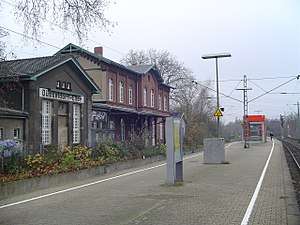Düsseldorf–Solingen railway
The Düsseldorf–Solingen railway is a railway in the German state of North Rhine-Westphalia. It is a 19 kilometre line, entirely double track and electrified with overhead line. It is now exclusively used by line S 1 of the Rhine-Ruhr S-Bahn.
| Düsseldorf–Solingen railway | |||||||||||||||||||||||||||||||||||||||||||||||||||||||||||||||||||||||||||||||||||||||||||||||||||||||||||||||||||||||||||||||||||||||||||||||||||||||||||||||||||||||||||||||||||||||||||||||||||||||||||||||||||||||
|---|---|---|---|---|---|---|---|---|---|---|---|---|---|---|---|---|---|---|---|---|---|---|---|---|---|---|---|---|---|---|---|---|---|---|---|---|---|---|---|---|---|---|---|---|---|---|---|---|---|---|---|---|---|---|---|---|---|---|---|---|---|---|---|---|---|---|---|---|---|---|---|---|---|---|---|---|---|---|---|---|---|---|---|---|---|---|---|---|---|---|---|---|---|---|---|---|---|---|---|---|---|---|---|---|---|---|---|---|---|---|---|---|---|---|---|---|---|---|---|---|---|---|---|---|---|---|---|---|---|---|---|---|---|---|---|---|---|---|---|---|---|---|---|---|---|---|---|---|---|---|---|---|---|---|---|---|---|---|---|---|---|---|---|---|---|---|---|---|---|---|---|---|---|---|---|---|---|---|---|---|---|---|---|---|---|---|---|---|---|---|---|---|---|---|---|---|---|---|---|---|---|---|---|---|---|---|---|---|---|---|---|---|---|---|---|
| Overview | |||||||||||||||||||||||||||||||||||||||||||||||||||||||||||||||||||||||||||||||||||||||||||||||||||||||||||||||||||||||||||||||||||||||||||||||||||||||||||||||||||||||||||||||||||||||||||||||||||||||||||||||||||||||
| Locale | North Rhine-Westphalia, Germany | ||||||||||||||||||||||||||||||||||||||||||||||||||||||||||||||||||||||||||||||||||||||||||||||||||||||||||||||||||||||||||||||||||||||||||||||||||||||||||||||||||||||||||||||||||||||||||||||||||||||||||||||||||||||
| Line number |
| ||||||||||||||||||||||||||||||||||||||||||||||||||||||||||||||||||||||||||||||||||||||||||||||||||||||||||||||||||||||||||||||||||||||||||||||||||||||||||||||||||||||||||||||||||||||||||||||||||||||||||||||||||||||
| Technical | |||||||||||||||||||||||||||||||||||||||||||||||||||||||||||||||||||||||||||||||||||||||||||||||||||||||||||||||||||||||||||||||||||||||||||||||||||||||||||||||||||||||||||||||||||||||||||||||||||||||||||||||||||||||
| Line length | 19 km (12 mi) | ||||||||||||||||||||||||||||||||||||||||||||||||||||||||||||||||||||||||||||||||||||||||||||||||||||||||||||||||||||||||||||||||||||||||||||||||||||||||||||||||||||||||||||||||||||||||||||||||||||||||||||||||||||||
| Track gauge | 1,435 mm (4 ft 8 1⁄2 in) standard gauge | ||||||||||||||||||||||||||||||||||||||||||||||||||||||||||||||||||||||||||||||||||||||||||||||||||||||||||||||||||||||||||||||||||||||||||||||||||||||||||||||||||||||||||||||||||||||||||||||||||||||||||||||||||||||
| Electrification | 15 kV/16.7 Hz AC overhead catenary | ||||||||||||||||||||||||||||||||||||||||||||||||||||||||||||||||||||||||||||||||||||||||||||||||||||||||||||||||||||||||||||||||||||||||||||||||||||||||||||||||||||||||||||||||||||||||||||||||||||||||||||||||||||||
| Operating speed | 120 km/h (75 mph) | ||||||||||||||||||||||||||||||||||||||||||||||||||||||||||||||||||||||||||||||||||||||||||||||||||||||||||||||||||||||||||||||||||||||||||||||||||||||||||||||||||||||||||||||||||||||||||||||||||||||||||||||||||||||
| Route number | 450.1 | ||||||||||||||||||||||||||||||||||||||||||||||||||||||||||||||||||||||||||||||||||||||||||||||||||||||||||||||||||||||||||||||||||||||||||||||||||||||||||||||||||||||||||||||||||||||||||||||||||||||||||||||||||||||
| |||||||||||||||||||||||||||||||||||||||||||||||||||||||||||||||||||||||||||||||||||||||||||||||||||||||||||||||||||||||||||||||||||||||||||||||||||||||||||||||||||||||||||||||||||||||||||||||||||||||||||||||||||||||
History
The section between Düsseldorf Hauptbahnhof and Düsseldorf-Eller was opened on 1 October 1891[2] by the Eisenbahndirektionen Cöln rechtsrheinisch (Railway division of Cologne Rhine Right Bank of the Prussian state railways). Between Eller and Hilden the line originally used the Troisdorf–Mülheim-Speldorf line, which was opened by the Rhenish Railway Company on 18 November 1874,[3] but separate tracks were opened in 1917.[4] The section between Hilden and Ohligs (now Solingen Hauptbahnhof) was opened on 3 January 1894.[5]
Rail services
S-Bahn services started operating over the line to Düsseldorf Airport Terminal on 27 October 1975; these services were eventually branded as line S 7. On 13 December 2009, line S 7 services were discontinued and operations on the Düsseldorf–Solingen line were taken over by an extension of line S 1 from Düsseldorf Hauptbahnhof. These services are operated at 20-minute intervals, using coupled sets of class 422 four-car electrical multiple units.[6]
There are plans to electrify the Wuppertal-Oberbarmen–Solingen railway and to extend the service to Remscheid and Wuppertal.
Fares
The entire line is in the area of the Verkehrsverbund Rhein-Ruhr (Rhine-Ruhr Transport Association), which establishes service levels and sets fares for it.
References
- Eisenbahnatlas Deutschland (German railway atlas). Schweers + Wall. 2017. p. 141. ISBN 978-3-89494-146-8.
- "Line 2413: Düsseldorf-Eller - Düsseldorf Hbf". NRW Rail Archive (in German). André Joost. Retrieved 2 October 2011.
- "Line 2324: Mülheim-Speldorf - Niederlahnstein". NRW Rail Archive (in German). André Joost. Retrieved 2 October 2011.
- "Line 2676: Düsseldorf-Eller - Hilden". NRW Rail Archive (in German). André Joost. Retrieved 2 October 2011.
- "Line 2671: Hilden - Solingen Hbf". NRW Rail Archive (in German). André Joost. Retrieved 2 October 2011.
- "Langenfeld S1: Dortmund - Essen Düsseldorf - Solingen". NRW Rail Archive (in German). André Joost. Retrieved 2 October 2011.
